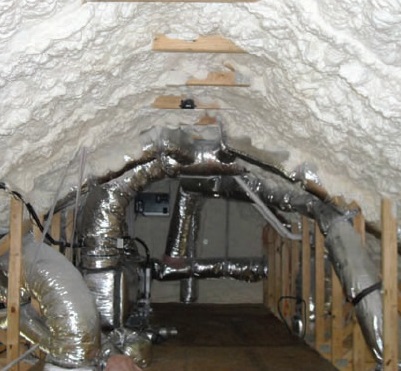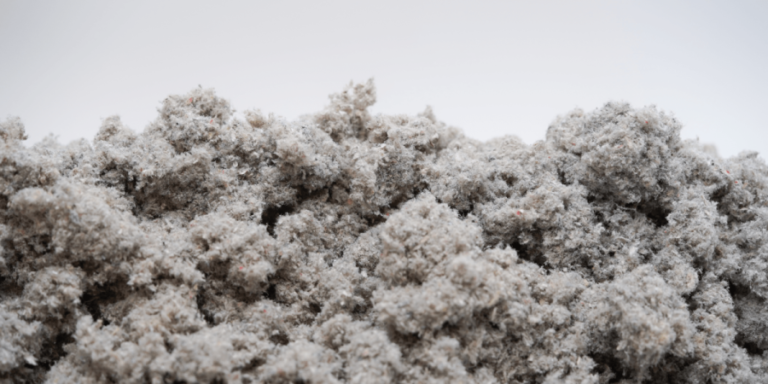Spray Foam Insulation In Phoenix, How To Stop The Heat
Installing spray foam insulation in your Phoenix area home can stop the scorching heat from impacting your comfort and energy efficiency. However, due to the extreme heat and the haphazard construction of many Valley homes, it would be best take the time needed to ensure you install your spray foam insulation correctly.
Video Of Spray Foam Insulation Application In A Phoenix Attic
If you install the best foam product for your particular project, you can expect years of consistent, comfortable temperatures throughout your home.
To better understand spray foam insulation in the hot Phoenix climate, you should first understand the common insulation shortcomings & mistakes present in most Valley homes.
Consequently, it will be easy to see why foam is the best solution for your home. And more importantly, you’ll be armed with the knowledge needed to make sure you insulate your attic correctly!
All Attics In Phoenix Have Spray Foam Insulation, Fiberglass, or Cellulose
If you research insulation online, you’ll quickly realize there are dozens of insulation products. However, one or more of the following three product categories are found in every attic in Phoenix: spray foam insulation, fiberglass, & cellulose.
Therefore, understanding the similarities and differences between these three products is essential to making an informed decision for your project.
Spray foam insulation is the most energy-efficient and long-lasting insulation product. Additionally, foam performs one function that no other products can. Which is, it protects the cool air in your ducts from the heat.
But, all insulation products will work well if you install them correctly. Furthermore, if you install fiberglass and cellulose correctly, it is a better solution than incorrectly installed spray foam insulation.
Unfortunately, most homes in the Phoenix area have incorrectly installed insulation. So, if your current insulation is underperforming, it is not necessarily a result of a low-quality product. But instead, the result of a substandard installation.
Insulation In New Homes Compared To Old Homes
To better understand insulation installation practices in Phoenix, first compare insulation from new homes to homes built before 2010.
New Homes
All new homes in the Phoenix area have spray foam insulation, fiberglass, or cellulose. But, most importantly, all new homes are air-sealed while under construction.
Pre-2010 Homes
Older homes, on the other hand, have fiberglass or cellulose insulation. However, nearly all homes constructed before 2010 are not air sealed.
When air leaks are present, there is no way for fiberglass and cellulose insulation to insulate to their full potential. Therefore, air sealing and insulation go hand-in-hand.
Air sealing without insulation has little impact on heat flow in your home. Likewise, insulation without air sealing reduces the performance of your insulation drastically.
To better understand the relationship between air sealing and insulation, first review the differences between the three main categories of insulation.
The Differences Between Spray Foam Insulation, Fiberglass, and Cellulose

Spray foam insulation performs better than fiberglass or cellulose because foam acts as an insulator and an air seal. Essentially, spray foam is two products in one.
Since fiberglass and cellulose only insulate and do not air seal, you must install them over an air-sealed surface. If you do not, heat will flow right through the insulation in the form of air leaks. In short, when air leaks are present, the insulation will not insulate.
Nevertheless, if installed correctly, fiberglass and cellulose will insulate as well as spray foam. Which means, the best insulation is correctly installed insulation.
The best insulation is correctly installed insulation.
| SPRAY FOAM | FIBERGLASS | CELLULOSE | |
| AIR SEAL | 100% | NONE | NONE |
| R-VALUE PER INCH | 2.5-7 | 3 | 3 |
| LONGEVITY | 50+ YRS | 10-20 YRS | 10 YRS |
Per inch of depth, spray foam insulation has similar insulating values to fiberglass and cellulose. However, the built-in air seal and longevity of foam distinguish it from fiberglass and cellulose.
Why is spray foam insulation still a better choice for my home if fiberglass and cellulose can work well?
In Phoenix, spray foam insulation fixes a significant comfort problem that fiberglass and cellulose cannot correct. That is, fiberglass and cellulose do not protect your air conditioning ducts from the heat. However, spray foam does.
Spray foam insulators apply foam to the bottom side of your roof. Which, in turn, encapsulates the ducts, similar to how a lid on a picnic cooler encapsulates the ice within. On the other hand, you install fiberglass and cellulose below the HVAC system. Consequently, the ducts remain exposed to extreme heat.
So, spray foam insulation protects your ducts from the desert heat by blocking the heat from entering the attic in the first place. As a result, the cool air in your ducts does not warm up as it travels through the attic.
Read this article to drill deeper into the products used for spray foam insulation in Phoenix and Tucson homes.
How do I know if my existing insulation is installed correctly?
Maybe you feel that your builder poorly installed your insulation, but how do you know for sure? After all, if your insulation is in good shape, then it would be a waste of money to fix it. Additionally, investing your resources into your insulation wouldn’t resolve your comfort problems.
Therefore, to better answer this question, break it into two questions.
Part 1: Are all the penetrations through your ceiling sealed?
If you have blown-in loose fiberglass or cellulose insulation, verify that your homebuilder sealed the penetrations into the attic. If gaps around the penetrations are present, air leaks will carry heat right through the insulation. Which in turn renders the insulation ineffective.
So, inspect your attic for sealed electrical boxes, recessed lighting, and wire penetrations. Additionally, verify that your builder caulked the edges of your interior wall top plates. Also, if you have soffits in your house, make sure they are covered and caulked at the edges.
Finally, pay particular attention to the exterior walls because this is where there are many air leaks. Also, this is where air leaks are the most difficult to seal.
Every attic has dozens of penetrations that you need to seal before you blow in fiberglass or cellulose insulation. Additionally, the fire code requires that you caulk all penetrations into the attic. Fires spread quickly through drafty gaps and cracks into the attic. So, air sealing is a safety issue as well as an energy efficiency concern.

The vapor barrier pictured above demonstrates the best way to install a continuous air seal in a home. A plastic vapor barrier ensures a complete air seal.
Homes with spray foam insulation in Phoenix are the only houses with vapor barriers. Despite being part of the energy code since 1991, Valley cites still does not require the installation of a vapor barrier. However, in a state like Arizona, there is a good argument for ignoring the portions of the code that address vapor control.
That argument is: we have a consistently dry climate. Consequently, vapor control is not necessary. Therefore, why run the risk of having a poorly installed vapor barrier trap moisture inside a structure.
However, a vapor barrier also doubles as an air-sealed surface. So, builders should take extra care – in the absence of a vapor barrier – to seal all of the penetrations through the exterior drywall envelope of your home.
Unfortunately, for most of Arizona’s long-term building boom, not enforcing the vapor barrier portion of the code also meant ignoring air sealing measures.

The picture above left shows a common air leak problem found in every attic in Phoenix. When contractors built the home, no one sealed the wire penetrations through the top of the interior walls. Additionally, they didn’t caulk the gaps along the edges of the wall.
As a result, these hidden air leaks are present throughout your house. Furthermore, when you install fiberglass or cellulose over these leaks, airflow pulls heat right through the insulation. Which, in turn, defeats the purpose of insulating.
The image on the right shows how you should seal these leaks before installing your insulation. If you block the leaks with canned spray foam insulation, it will meet Phoenix energy code and manufacturer’s specifications.
Air sealing before insulating your attic is critical. To ensure the insulation blocks heat correctly, you must meet an additional standard in addition to air sealing, which leads to part two of our answer.
Part 2: Does your insulation have good contact with the ceiling (air-sealed surface)?
Fiberglass and cellulose must directly contact the air-sealed surface to work as designed. So, wherever there is a gap between your insulation and drywall, the insulation is underperforming. It does not matter if the gap is 1/16″ or 1″. As soon as the two materials lose contact, the insulation performance drops.
Fiberglass and cellulose only block one type of heat flow, conduction. Conduction is heat flow through materials. So, to work correctly, the insulation material must have good contact with the material that it is insulating, like drywall, for example. The material you want to insulate in your home is the drywall on the exterior walls and the ceiling.
If the insulation does not contact the material it is insulating; it can’t insulate it! Would you carry your shoes in your hands while on a walk? Of course not; they won’t help you at all unless they are on your feet. Likewise, fiberglass and cellulose must be in contact with the material they are protecting from the heat. Otherwise, like the shoes in your hands, they aren’t helping much.
Only A Problem With Fiberglass Batts, & Mostly In Walls
In all attics with cellulose insulation or blown-in fiberglass, there is excellent contact with the drywall. So, if you have cellulose or blown fiberglass in your attic, you do not have a contact problem. After all, the insulation is resting directly on top of the drywall.
However, if your attic has fiberglass batts, you need to confirm good contact between the batts and drywall. In Phoenix, fiberglass batts in attics, and especially the walls, never have good contact with the drywall.

For example, the stock photo (above left) demonstrates how not to install fiberglass insulation. The worker is pushing the fiberglass up between the roof joists. When the project is complete, there will be a small gap between the fiberglass and drywall. Consequently, the insulation pictured will not insulate well.
The two photos on the right show electrical wires underneath fiberglass batts, a common condition in Phoenix attics. When the fiberglass rests on top of electrical wires, it has no contact with the drywall, reducing its insulating capacity.
Batts Are In Vaults
If you have flat ceilings, do not have fiberglass batts in your attic. But, if you have a vaulted ceiling in your home, you might have fiberglass batt insulation in the vault.
In Phoenix, insulators install fiberglass batts by lodging them in between roof trusses. The tension in the insulation holds it in place before the drywallers cover the ceiling. After that, they insulate the walls the same way.
While this method is fast and easy to do, it guarantees that the insulation will not have sufficient contact with the drywall. As a result, it will not meet code, nor will it perform to the insulating values specified by the manufacturer.
Incorrectly installed fiberglass batts are the source of discomfort and high utility bills in tens of thousands of homes in the Phoenix and Tucson areas.
What about spray foam insulation and air sealing?
Spray foam insulation is not only an insulation product but also is an air-sealing product. Consequently, none of the air sealing measures required for fiberglass and cellulose are necessary. However, you must install spray foam insulation correctly to create an air seal.
Installing foam in an attic is like putting a lid on a cooler filled with ice. If you place the cover on tightly, the ice will not melt for a long time. But, if you leave a small crack, hot air will leak into the cooler and melt the ice.
Similarly, spray foam insulation must create a tight lid on your attic. If you miss one square foot, or even worse, if you miss a small air leak on the perimeter, heat will leak into the attic. Once the heat enters the attic, the attic begins to warm up.
Consequently, one hundred percent of the roof deck must be covered so the foam works correctly. When it comes to foam, minor errors lead to considerable performance reductions.
Is a permit needed in Phoenix for spray foam insulation?
Phoenix does not have a spray foam insulation permit requirement. Nor do any other cities in the Valley. However, the insulation work should still meet all the pertinent building codes.
What is the process to spray foam insulate an attic?
Your contractor must take the following steps to install the insulation correctly and create an air seal:
First, remove all of the existing insulation from the attic.
Make sure your contractor pays particular attention to the insulation in the eves. Since the eve areas are tightly cramped, they take about 80% of the total removal time, even though they contain only 10-15% of the entire insulation. Consequently, leaving existing insulation in the eves before installing foam will result in many air leaks into the attic.
Second, build a partition wall between the house attic and garage attic.
Since the garage is not cooled, you must separate the garage attic from the house attic with a foam barrier.
Third, if there is no attic access from the living space, install a sealed door in the wall between the garage attic and the house attic.
Forth, apply a 6″ deep layer of 0.50 pound per cubic foot spray foam insulation to the attic’s entire perimeter and roof deck. When installed correctly in a clean attic, the foam will block all air leaks and heat from entering the attic.
And finally, install a temperature sensor in the attic with a digital display in the house. The sensor will help you monitor your attic temperatures through the summer months.
What type of foam do you need for your attic?
Existing Attics
If you are insulating an existing attic with spray foam insulation in the Phoenix area, install six inches of 0.5 lb ft³ density open-cell foam. Make sure the insulation is fire code compliant without the addition of a spark-resistant coating.
Due to the confined spaces in an existing attic, it is impossible to apply a spark-resistant coating to the surface of the foam in a manner that will be fire-code compliant. Therefore, keep yourself safe and free from future liability by installing a foam product that is fire code-compliant without a coating.
New Construction
If you plan to insulate a new construction attic, you can install a product that requires a spark-resistant coating to make it fire-code compliant. It is safe to apply the spray foam insulation in new construction first, followed by spark-resistant paint. Because there is no drywall on the ceiling, it is simple to install the coating correctly.
Also, many products do not need a coating in new construction if all of the penetrations into the attic are fire sealed. Additionally, the attic access hatch must be fire-rated.
Fire sealing attic penetrations are now a standard part of building a home in Phoenix. As a result, regardless of what type of insulation you use, you won’t incur any additional costs besides the fire-rated attic access hatch cost.
What makes spray foam insulation fire code compliant?
Two factors determine whether a spray foam product is fire code compliant or not.
Factor #1: The foam insulation material
Spray foam insulation products that pass the Appendix X Fire test without a coating are fire code compliant right out of the barrel. They do not require a spark-resistant coating, fire sealing of wire penetrations, or modifications to the attic access hatch.
However, products that do not pass the Appendix X test without a coating must have spark-resistant paint installed over the surface of the foam.
Some products do not pass the Appendix X test but do pass a less stringent test. These products do not require a coating if you make other improvements to the attic. These measures include structural modifications to the attic access hatch and fire sealing all penetrations into the attic.
Factor #2: The construction of the attic.
If a spray foam insulation product is not fire-code compliant out of the barrel, you can modify the attic to bring the foam into compliance. However, this is not an option for existing homes.
Usually, you need to install a fire-rated attic access hatch to make an attic fire code compliant. Additionally, it would be best to seal all wire and plumbing penetrations into the attic with fire-rated caulk.
If you have an existing home, install Appendix X compliant spray foam in your attic to ensure you are fire code compliant.
How long does an installation take?
Installations take one to four days to complete, but the majority of projects take two days. The installation time frame depends on the type & depth of the existing insulation, the size of the attic, the roof pitch, the attic framing, and what percentage, if any, of the ceilings are vaulted.
If your attic access hatch is inside of your house, you’ll need to provide access to the spray foam insulators. However, if the hatch is in your garage, technicians can complete the project without entering the home’s living space.
I have a gas heater/furnace in my attic, is foam still an option?
Yes. In some situations, you may need an air chamber around the air intake of your furnace. We use the fuel gas code guidelines to calculate whether or not an air chamber is required. If required by code, we will build and install an air chamber on your heater.

The gas heater pictured above may require a fresh air chamber after you seal the attic with foam insulation. The following are the factors used to determine whether you need a fresh air supply:
- Total BTUs of the heater
- Cubic feet of the attic.
- Cubic feet of the house.
How will foam impact my HVAC system?
Insulating your attic with foam is the best thing you can do for your HVAC system. Without spray foam insulation, your HVAC system operates in an attic that often exceeds 150° in the summertime.
The cold air that comes out of the HVAC system at 55°-60° can warm up by 5°-10° as it passes through the hot ductwork in the attic, especially in longer ducts.
After you install the foam, the air inside of the ductwork stays cool, even on the hottest summer evenings. As a result, every HVAC register in your house will blow consistent cold air. Therefore, duct length will no longer be a factor in the temperature differences between rooms.
What can I expect after the project is complete?
You can expect consistently cold air blowing out of every AC register throughout the house and lower utility bills.
Also, your AC will last longer because of the reduced stress on the HVAC system. Furthermore, when the time comes to replace your AC system, you’ll be able to install a more undersized AC because the foam reduces the heat load on the house.
A secondary benefit of spray foam insulation in your attic is dramatically reduced dust in the house. Old insulation is a significant source of house dust. After removing the old insulation and sealing the attic with foam, you’ll notice less dust throughout the house.
Thirdly, you’ll never have to mess with your insulation again. Foam is a plastic material. And like other plastic materials, it lasts for generations.
Final Thoughts
Even though foam is the best product you can install in your home, like fiberglass and cellulose, it still needs to be installed correctly to insulate to its full potential. So, do your research ahead of time and select a competent spray foam insulation company. Then, when everything goes by the book, you’ll enjoy the benefits of the foam for decades to come.



